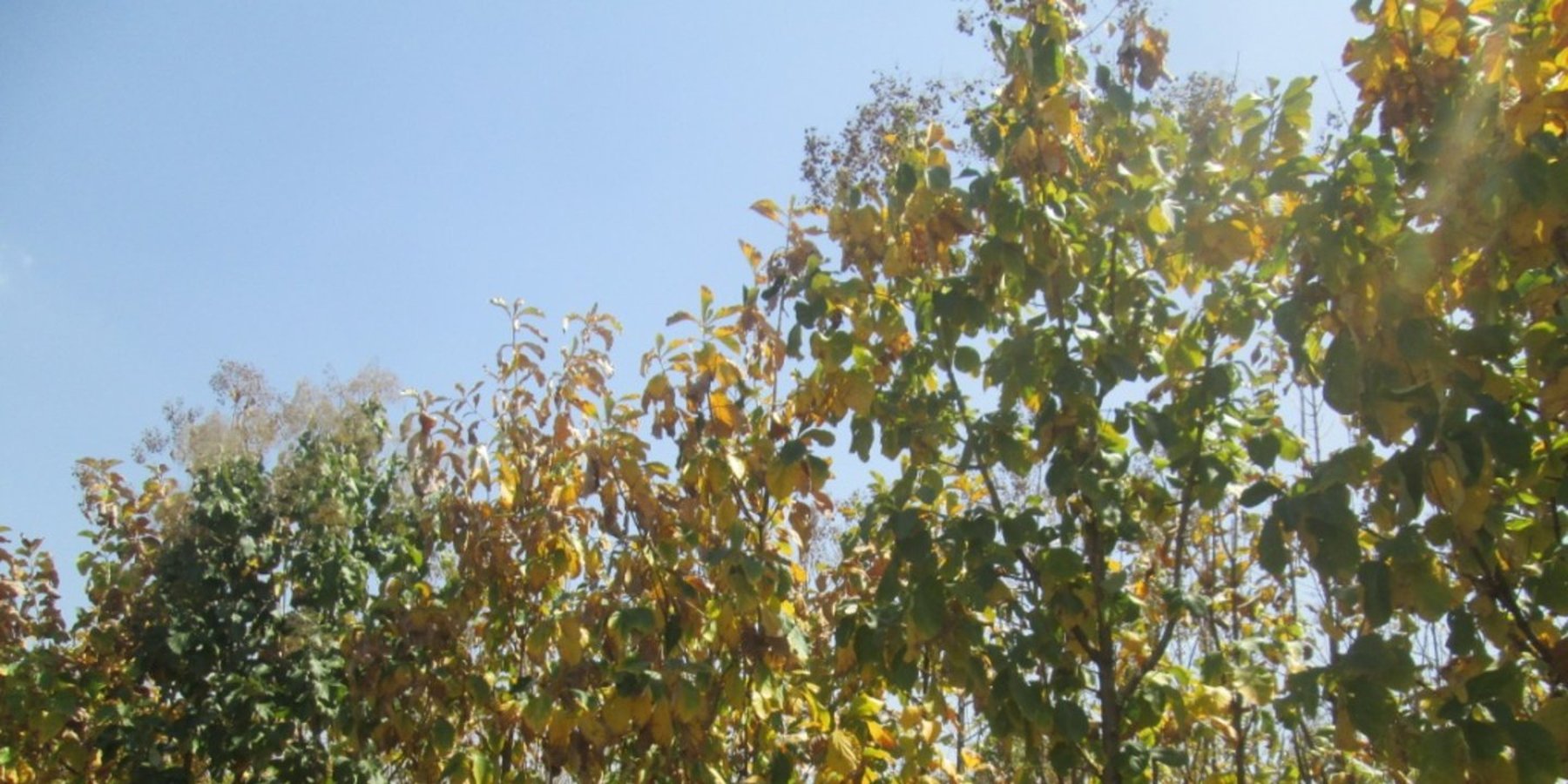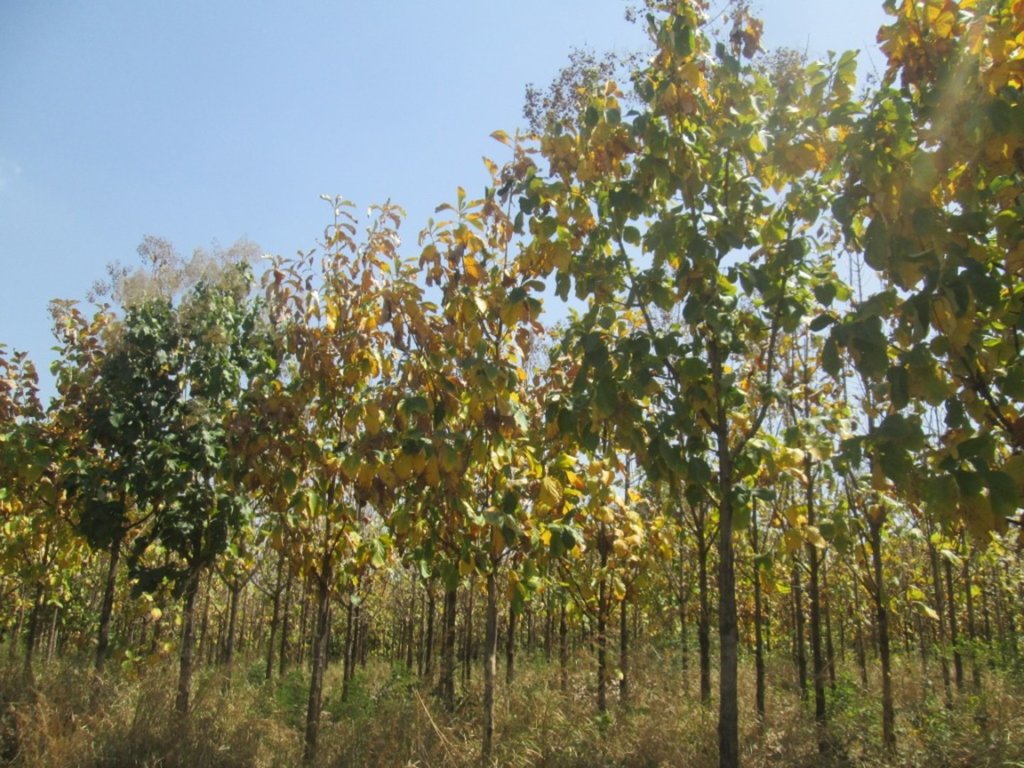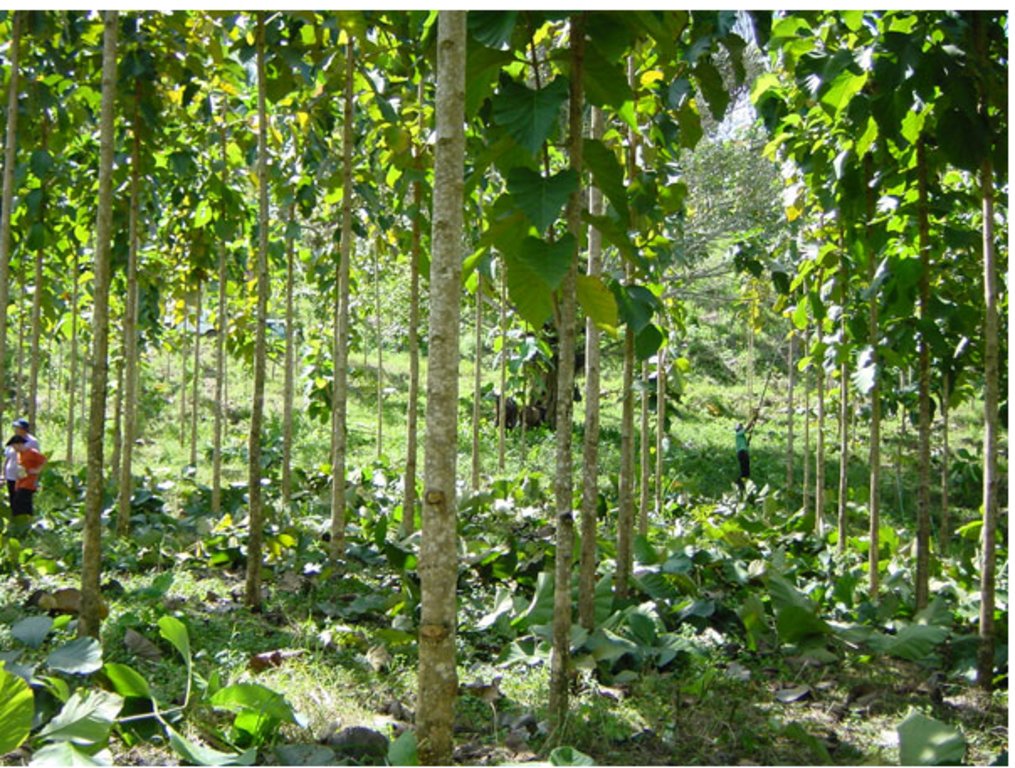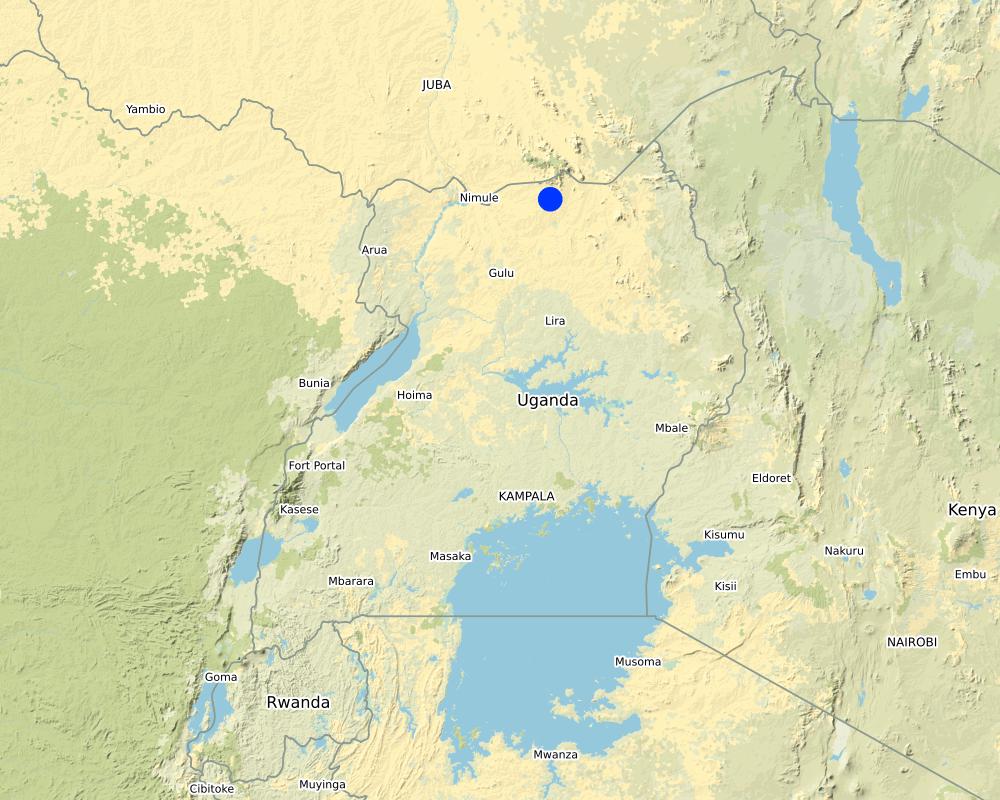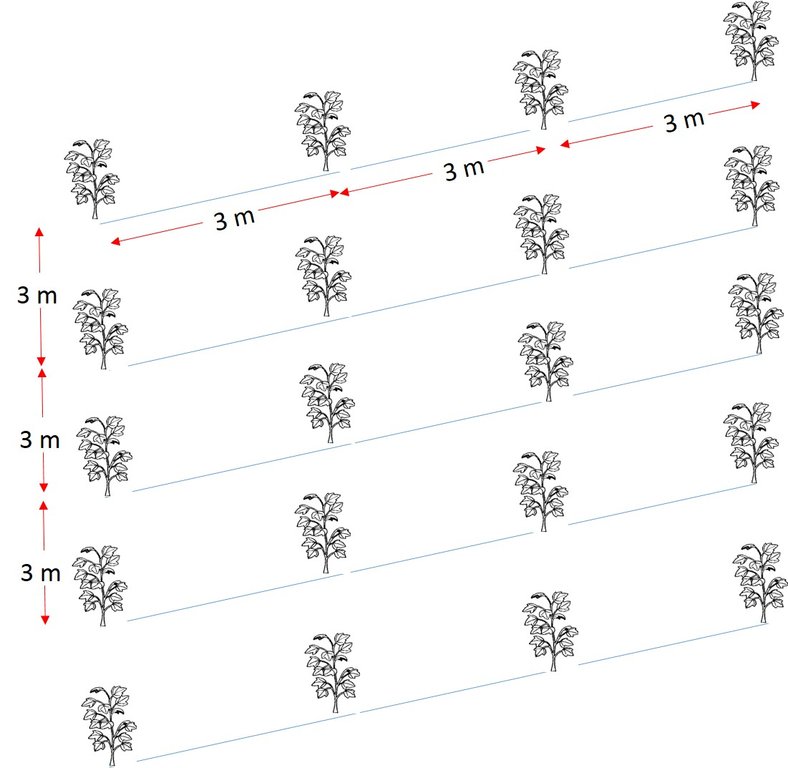Teak-Based Afforestation for Timber Production [乌干达]
- 创建:
- 更新:
- 编制者: Bernard Fungo
- 编辑者: JOY TUKAHIRWA, Kamugisha Rick Nelson, betty adoch, Sunday Balla Amale
- 审查者: Nicole Harari, Udo Höggel
Bonga teak
technologies_2882 - 乌干达
查看章节
全部展开 全部收起1. 一般信息
1.2 参与该技术评估和文件编制的资源人员和机构的联系方式
关键资源人
土地使用者:
Lam Charles
+256789574158
Katom E. B
Patibe sub county. Lamwo district
乌干达
有助于对技术进行记录/评估的项目名称(如相关)
Scaling-up SLM practices by smallholder farmers (IFAD)有助于对技术进行记录/评估的机构名称(如相关)
CDE Centre for Development and Environment (CDE Centre for Development and Environment) - 瑞士1.3 关于使用通过WOCAT记录的数据的条件
编制者和关键资源人员接受有关使用通过WOCAT记录数据的条件。:
是
1.4 所述技术的可持续性声明
这里所描述的技术在土地退化方面是否存在问题,导致无法被认为是一种可持续的土地管理技术?:
否
2. SLM技术的说明
2.1 技术简介
技术定义:
Teak (Tectona grandis) is preferred as a timber species in northern Uganda because the tree species better endures drought conditions compared to other species such as Pine. A tree plantation of Teak is established mainly to provide timber but also sequester atmospheric carbon and act as wind break.
2.2 技术的详细说明
说明:
Drought-tolerant Teak (Tectona grandis) is suitable for planting in semi-arid areas. In northern Uganda, farmers are establishing plantations of Teak for timber production as opposed to other plantation species like Pines and clonal Eucalyptus.
Seeds are raised in pots, small seedling containers in which they grow into seedlings. When the rains start, usually around April, or September, the seedlings are planted out, with 1,100 seedlings planted per hectare. Teak trees are planted at a spacing of 3 x 3 meters and thinned at 5 and 9 years to retain approximately 450 trees per hectare. To ensure that the timber produced from the trees does not have knots, pruning is done to remove lower branches as the tree grows. Pruning is normally done starting at the age of 3 years. Like most tree planting projects, framers tend to plan Teak on less productive land, leaving the fertile parts of their land for food and other high-value cash crops.
The cost of establishing a Teak plantations is high in the first 2-3 years but reduces significantly after first thinning. The cost of weeding can be reduced by spot-weeding of seedlings up to age 3 years, after which slashing or spraying with herbicides (usually Round-up) is used for weed control. Wood from thinning is also sold as firewood or construction poles to recover some the establishment costs. Shading of leave by Teak is heavy during the dry season and this causes a risk of fire. Therefore, fire control is done by establishing a fine-line, an open space of 6 meters to separate the plantation into compartments in order to restrict fire from spreading from one part to another part.
Farmers like Teak because it endures dry conditions and can provide high-quality timber. Although not exploited yet, these Teak plantations can be used for carbon trade and further improve the income of the farmer. What farmers do not like about Teak is that unlike several other specie where livestock can be integrated in the plantation, it is not possible for teak because it does not support undergrowth.
2.3 技术照片
2.4 技术视频
注释、简短说明:
Video on Teak based afforestation in Lamwo District
日期:
12/5/2017
位置:
Lamwo
2.5 已应用该技术的、本评估所涵盖的国家/地区/地点
国家:
乌干达
区域/州/省:
Northern
有关地点的进一步说明:
Padibe s/county Lamwo District
Map
×2.6 实施日期
注明实施年份:
2012
2.7 技术介绍
详细说明该技术是如何引入的:
- 通过土地使用者的创新
3. SLM技术的分类
3.1 该技术的主要目的
- 适应气候变化/极端天气及其影响
- 减缓气候变化及其影响
3.2 应用该技术的当前土地利用类型

森林/林地
植树造林:
- 单一栽培的外来品种
产品和服务:
- 木材
- 薪材
- 自然灾害防护
3.3 有关土地利用的更多信息
该技术所应用土地的供水:
- 雨养
每年的生长季节数:
- 2
3.4 该技术所属的SLM组
- 森林种植管理
3.5 技术传播
具体说明该技术的分布:
- 均匀地分布在一个区域
如果该技术均匀地分布在一个区域上,请注明覆盖的大致区域。:
- < 0.1 平方千米(10 公顷)
3.6 包含该技术的可持续土地管理措施

植物措施
- V1:乔木和灌木覆盖层

管理措施
- M5:物种组成的控制/变化
3.7 该技术强调的主要土地退化类型

生物性退化
- Bc:植被覆盖的减少
3.8 防止、减少或恢复土地退化
具体数量名该技术与土地退化有关的目标:
- 适应土地退化
4. 技术规范、实施活动、投入和成本
4.1 该技术的技术图纸
4.2 技术规范/技术图纸说明
Seeds of Teack (Tectona grandis) are first raised in a nursery until they are 4 months old
Planting is done at the start of the rainy season (April or September)
Spacing between trees is 3 x 3 meters
Weeding is done by spot-weeding to reduce labour and soil disturbance
Pruning is done starting at the age of 3 years
Thinning is done at 5 and 9 years
4.3 有关投入和成本计算的一般信息
具体说明成本和投入是如何计算的:
- 每个技术区域
注明尺寸和面积单位:
5 Acres
其它/国家货币(具体说明):
Uganda Shillings
注明美元与当地货币的汇率(如相关):1美元=:
3500.0
注明雇用劳工的每日平均工资成本:
5000
4.4 技术建立活动
| 活动 | 措施类型 | 时间 | |
|---|---|---|---|
| 1. | Raising seedlings in the nursery | 农业学的 | At the start of the establishment of the technology |
| 2. | Land clearing | 管理 | Once at the start of the establishment of the technology |
| 3. | Pitting and Planting | 管理 | Once at the start of the establishment of the technology |
| 4. | Weeding | 农业学的 | Once every year |
| 5. | Pruning | 农业学的 | At age 3 and 7 years |
| 6. | Thinning | 农业学的 | At age 5 and 9 years |
| 7. | Protection against fire | 管理 | Every year |
4.5 技术建立所需要的费用和投入
| 对投入进行具体说明 | 单位 | 数量 | 单位成本 | 每项投入的总成本 | 土地使用者承担的成本% | |
|---|---|---|---|---|---|---|
| 劳动力 | Raising seedlings in the nursry | Mandays | 120.0 | 5000.0 | 600000.0 | 100.0 |
| 劳动力 | Land clearing | Acre | 1.0 | 200000.0 | 200000.0 | 100.0 |
| 劳动力 | Planting | Acre | 1.0 | 200000.0 | 200000.0 | 100.0 |
| 设备 | Watering Cans | Number | 3.0 | 10000.0 | 30000.0 | 100.0 |
| 设备 | Jerricans | Number | 5.0 | 8000.0 | 40000.0 | 100.0 |
| 植物材料 | Seeds of Teak | kg | 1.0 | 100000.0 | 100000.0 | 100.0 |
| 施工材料 | Poles for the nursery | Number | 30.0 | 5000.0 | 150000.0 | 100.0 |
| 施工材料 | Grass for shading the seedlings | Bundles | 10.0 | 10000.0 | 100000.0 | 100.0 |
| 技术建立所需总成本 | 1420000.0 | |||||
4.6 维护/经常性活动
| 活动 | 措施类型 | 时间/频率 | |
|---|---|---|---|
| 1. | Weeding | 管理 | Every year |
| 2. | Pruning | 管理 | At age 3 through 7 years |
| 3. | Thining | 管理 | At 5 and 9 years |
4.7 维护/经常性活动所需要的费用和投入(每年)
| 对投入进行具体说明 | 单位 | 数量 | 单位成本 | 每项投入的总成本 | 土地使用者承担的成本% | |
|---|---|---|---|---|---|---|
| 劳动力 | Weeding | Acre | 1.0 | 150000.0 | 150000.0 | 100.0 |
| 劳动力 | Pruning | Acre | 1.0 | 200000.0 | 200000.0 | 100.0 |
| 劳动力 | Thinning | Acre | 1.0 | 200000.0 | 200000.0 | 100.0 |
| 劳动力 | Regular patrol for fire protection | Years | 15.0 | 600000.0 | 9000000.0 | 100.0 |
| 设备 | Hoes | Number | 5.0 | 15000.0 | 75000.0 | 100.0 |
| 设备 | Pangas | Number | 5.0 | 8000.0 | 40000.0 | 100.0 |
| 设备 | Pruning saws | Number | 5.0 | 20000.0 | 100000.0 | 100.0 |
| 技术维护所需总成本 | 9765000.0 | |||||
4.8 影响成本的最重要因素
描述影响成本的最决定性因素:
Raising seedlings and planting
5. 自然和人文环境
5.1 气候
年降雨量
- < 250毫米
- 251-500毫米
- 501-750毫米
- 751-1,000毫米
- 1,001-1,500毫米
- 1,501-2,000毫米
- 2,001-3,000毫米
- 3,001-4,000毫米
- > 4,000毫米
农业气候带
- 半湿润
5.2 地形
平均坡度:
- 水平(0-2%)
- 缓降(3-5%)
- 平缓(6-10%)
- 滚坡(11-15%)
- 崎岖(16-30%)
- 陡峭(31-60%)
- 非常陡峭(>60%)
地形:
- 高原/平原
- 山脊
- 山坡
- 山地斜坡
- 麓坡
- 谷底
垂直分布带:
- 0-100 m a.s.l.
- 101-500 m a.s.l.
- 501-1,000 m a.s.l.
- 1,001-1,500 m a.s.l.
- 1,501-2,000 m a.s.l.
- 2,001-2,500 m a.s.l.
- 2,501-3,000 m a.s.l.
- 3,001-4,000 m a.s.l.
- > 4,000 m a.s.l.
说明该技术是否专门应用于:
- 不相关
5.3 土壤
平均土层深度:
- 非常浅(0-20厘米)
- 浅(21-50厘米)
- 中等深度(51-80厘米)
- 深(81-120厘米)
- 非常深(> 120厘米)
土壤质地(表土):
- 中粒(壤土、粉土)
土壤质地(地表以下> 20厘米):
- 中粒(壤土、粉土)
表土有机质:
- 中(1-3%)
5.4 水资源可用性和质量
地下水位表:
5-50米
地表水的可用性:
好
水质(未处理):
仅供农业使用(灌溉)
水的盐度有问题吗?:
否
该区域正在发生洪水吗?:
否
5.5 生物多样性
物种多样性:
- 中等
栖息地多样性:
- 中等
5.6 应用该技术的土地使用者的特征
定栖或游牧:
- 定栖的
生产系统的市场定位:
- 混合(生计/商业
非农收入:
- 收入的10-50%
相对财富水平:
- 平均水平
个人或集体:
- 个人/家庭
机械化水平:
- 手工作业
性别:
- 女人
- 男人
土地使用者的年龄:
- 青年人
- 中年人
5.7 应用该技术的土地使用者拥有或租用的平均土地面积
- < 0.5 公顷
- 0.5-1 公顷
- 1-2 公顷
- 2-5公顷
- 5-15公顷
- 15-50公顷
- 50-100公顷
- 100-500公顷
- 500-1,000公顷
- 1,000-10,000公顷
- > 10,000公顷
这被认为是小规模、中规模还是大规模的(参照当地实际情况)?:
- 小规模的
5.8 土地所有权、土地使用权和水使用权
土地所有权:
- 个人,未命名
土地使用权:
- 个人
用水权:
- 个人
5.9 进入服务和基础设施的通道
健康:
- 贫瘠
- 适度的
- 好
教育:
- 贫瘠
- 适度的
- 好
技术援助:
- 贫瘠
- 适度的
- 好
就业(例如非农):
- 贫瘠
- 适度的
- 好
市场:
- 贫瘠
- 适度的
- 好
能源:
- 贫瘠
- 适度的
- 好
道路和交通:
- 贫瘠
- 适度的
- 好
饮用水和卫生设施:
- 贫瘠
- 适度的
- 好
金融服务:
- 贫瘠
- 适度的
- 好
6. 影响和结论性说明
6.1 该技术的现场影响
社会经济效应
生产
木材生产
森林/林地质量
能源生产
收入和成本
农业投入费用
农业收入
收入来源的多样性
工作量
生态影响
减少气候和灾害风险
干旱影响
风速
6.2 该技术的场外影响已经显现
风力搬运沉积物
6.3 技术对渐变气候以及与气候相关的极端情况/灾害的暴露和敏感性(土地使用者认为的极端情况/灾害)
渐变气候
渐变气候
| 季节 | 气候变化/极端天气的类型 | 该技术是如何应对的? | |
|---|---|---|---|
| 季节性温度 | 旱季 | 增加 | 适度 |
6.4 成本效益分析
技术收益与技术建立成本相比如何(从土地使用者的角度看)?
短期回报:
消极
长期回报:
非常积极
技术收益与技术维护成本/经常性成本相比如何(从土地使用者的角度看)?
短期回报:
积极
长期回报:
非常积极
6.5 技术采用
- 1-10%
在所有采用这项技术的人当中,有多少人是自发地采用该技术,即未获得任何物质奖励/付款?:
- 90-100%
6.6 适应
最近是否对该技术进行了修改以适应不断变化的条件?:
否
6.7 该技术的优点/长处/机会
| 土地使用者眼中的长处/优势/机会 |
|---|
| Teak is drought-tolerant and and provides high quality timber which, guarantees profits from the investment |
| Other ecological benefits can be realized from the plantation, such as the role of wind breaks and carbon sequestration |
6.8 技术的弱点/缺点/风险及其克服方法
| 土地使用者认为的弱点/缺点/风险 | 如何克服它们? |
|---|---|
| The cost of establishing the plantation is high for majority farmers in the area | Community nurseries can provide seedlings to reduce establishment costs |
| The risk of fire during the dry season is very high | Protection against fire has to be considered as part of the investment, to construct fire lines and regular patrols |
7. 参考和链接
7.1 信息的方法/来源
- 实地考察、实地调查
2
- 与土地使用者的访谈
1
链接和模块
全部展开 全部收起链接
无链接
模块
无模块


